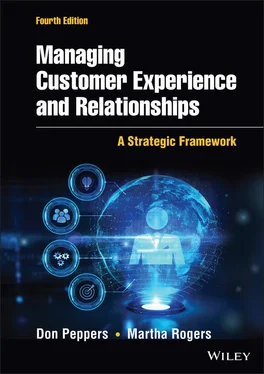Yet another characteristic of a relationship, so obvious it might not seem worth mentioning, is uniqueness . Every relationship is different. Relationships are constituted with individuals, not with populations. As a result, an enterprise that seeks to engage its customers in relationships must be prepared to participate in different interactions, remember different histories, and engage in different behaviors toward different customers. You will not have the same relationship with your waitperson at a restaurant as you do with your business mentor.
Finally, the ultimate requirement and product of a successful, continuing relationship is trust . Trust is a quality worth a book all by itself, 9 but fundamentally what we are talking about is the commonsense proposition that if customers develop a relationship with an enterprise, they tend more and more to trust the enterprise to act in their own interest. Trust, and affection, and satisfaction are all related feelings on the part of a customer toward a company with which they have a relationship. They constitute the more emotional elements of a relationship, but for an enterprise to acknowledge and use these elements profitably, it must be able to reconcile its own cultureand behavior with the requirement of generating and sustaining the trust of a customer. (For more on this issue, see Chapters 3and 8.)
Over 20 years ago, business professors Jag Sheth and Atul Parvatiyar predicted that companies are “likely to undertake efforts to institutionalize the relationship with consumers—that is, to create a corporate bonding instead of a bonding between a frontline salesperson and consumer alone.” 10
Customer orientationis powerful in theory but, some say, troubled in practice. In some industries, customer satisfaction rates in the United States fall, while complaints, boycotts, and other consumer discontent rise, fueled in magnitude and velocity by social media. Some say there has been a decline in the fundamentals of relationship building among enterprise executives who are more concerned with increasing quarterly profits for their own sake than establishing closer ties to profitable customers. Every aspect of managing customer relationships and experiences is affected by the firm's understanding of relationships in general. Enterprises must fully comprehend the basic foundations of relationships, and the basic principles of the Learning Relationship in particular, before embarking on a customer relationship or customer experience initiative.
Views on business relationships vary, but all provide a relevant perspective to building a relationship framework. We acknowledge that a company may attempt to build a relationship with a customer that the customer has no emotional interest in. By learning from a customer, or a small group of customers with similar needs and behaviors, the company may be able to offer the right product at the right time and provide convenience to a customer who may not be emotionally attached to the product or company but does more and more business with it because it's easier to continue with the current provider than to switch. In many other cases, of course, the relationship is specifically enjoyed by the customer, at the extreme by the Harley-Davidson customer who tattoos the company's brand on their bicep.
We have discussed the foundation of relationship theory and the benefits of getting, keeping, and growing customers. So far, the discussion has included concepts that foster an often-emotional involvement between the customer and the enterprise. The Learning Relationship is a highly personal experience for the customer that ensures that it is always in the customer's self-interest to remain with the enterprise with which they first developed the relationship. We believe this may go beyond a customer's emotional attachment or favoritism for any enterprise; it may also be derived from some sense of obligation. However, many scholars believe that by establishing a Learning Relationship, the customer-focused enterprise increases customer retention by making loyalty more beneficial for the customer than non-loyalty. Others believe that the relationship exists even if a customer is not aware of it and only benefits from a better customer experience. See Jim Barnes for more views on this subject. 11
CUSTOMER LOYALTY: IS IT EMOTIONAL? OR BEHAVIORAL?
Definitions of customer loyalty usually take one of two directions: emotional or behavioral. Although each of these directions is valid, when used separately, they have different implications and lead to very different prescriptions for businesses. The most helpful way for businesses to approach the issue of improving customer loyalty is to rely on both these definitions simultaneously.
Emotional loyaltyimplies that the loyalty of a customer is in the customer's state of mind. By this definition, a customer is loyal to a brand or a company if they have positive, preferential attitude toward it. They like the company, its products, its services, or its brands, and therefore prefer to buy from it, rather than from the company's competitors. In purely economic terms, the emotional definition of customer loyalty would mean that someone who is willing to pay a premium for Brand A over Brand B, even when the products they represent are virtually equivalent, should be considered loyal to Brand A. But the emphasis is on willingness rather than on actual behavior. In terms of attitudes and emotions, increasing customer loyalty is virtually equivalent to increasing their preference for the brand. It is closely tied to customer satisfaction, and any company wanting to increase loyalty, in emotional terms, will concentrate on improving its product, its image, its service, or other elements of the customer experience, relative to its competitors. 12
Behavioral loyalty, however, relies on a customer's actual conduct, regardless of the attitudes or preferences that underlie that conduct. By this definition, a customer should be considered loyal to a company simply because they buy from it and then continue to buy from it. Behavioral loyalty is concerned with repurchase activity rather than attitudes or preferences. Thus, it is theoretically possible for customers to be loyal to a brand even if they don't really like it, provided there are other reasons for repeat purchase. For instance, a discount airline with poor service standards but prices that are significantly lower than competitors might have customers who are behaviorally loyal but not emotionally loyal. (Some Londoners lament that they hate RyanAir every weekend they “had” to take it to Mallorca, for a no-frills airfare that is often less than $25 roundtrip!) Similarly, a business-to-business firm selling complex services may rely on long-term contracts in order to ensure it is adequately compensated for high setup costs. (We once participated in a meeting with high-tech executives at their headquarters in which one of the executives joked that their primary customer loyalty tactic was probably the lawsuit.) In its most raw form, behavioral loyalty is similar to what can be described as functional loyalty,in that there is no emotional content or sense of attachment to the company on the customer's part.
In the behavioral definition, customer loyalty is not the cause of brand preference but simply one result of it, and brand preference is not the only thing that might lead to behavioral loyalty. A company wanting to increase behavioral customer loyalty will focus on whatever tactics will increase the amount of repurchase. These tactics can easily include improving brand preference, product quality, or customer satisfaction, but they may also include long-term legal contracts or prices so low that service is almost nonexistent.
Читать дальше












